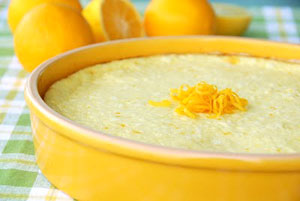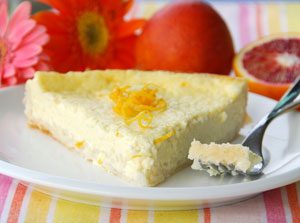 "Hi, Mom. Can I have your recipe for rice pie?"
"Hi, Mom. Can I have your recipe for rice pie?"
"You mean Nan's recipe? I've always made Nan's recipe."
"OK, then can I have Nan's recipe for rice pie?"
"What for, your ba - log?"
"Yeah, I want to do a post on Italian Easter pies."
"Ooh, isn't that nice, honey."
(silence)
"So, do you still have the recipe?"
"Yeah, first you start with -- "
"What, you found the recipe already?"
"Aaaa-y I've been makin' rice pies for so many years, I know it by heart. First, you start with 2 dozen eggs, then you add --"
"Two dozen eggs? Ma, it's just Jeff and me, remember?"
"Yeah, but you want it to come nice and thick. Plus, you only have it once a year, so you might as well make a big one."
"How big?"
"Make it in like a deep 15 X 13 inch dish."
"Ma, I couldn't even fit a dish that big in my kitchen cupboard."
"Well, if you had told me sooner, I would have sent you one. I've got a couple extra in the basement."
This is the essence of an Italian mom -- she always wants you to eat, and she's always ready to give you something.
Growing up in my family, Easter was defined by my mother's Italian rice pies and my grandmother's famous Italian Ricotta Pie with Pineapple, which was so good, it practically caused a family feud back in the day.
 Of all the Easter pies, my favorite has always been rice pie (torta di riso). Though there are regional variations for it, most sweet rice pies are made from eggs, rice (usually Arborio), ricotta cheese, and citrus (orange, lime, or, most popularly, lemon).
Of all the Easter pies, my favorite has always been rice pie (torta di riso). Though there are regional variations for it, most sweet rice pies are made from eggs, rice (usually Arborio), ricotta cheese, and citrus (orange, lime, or, most popularly, lemon).
What makes Italian rice pie so irresistible? It's like having two pies in one. When it bakes, a bottom layer of dense, chewy rice forms that is topped with a separate layer of creamy, lemon-laced custard. (I even added Meyer lemon zest because there is no such thing a rice pie that is too lemony.)
Rice pie is traditionally served alongside ricotta pie for Easter Sunday dessert, but I'll let you in on a secret: the best time to eat it is Monday morning. Rice pie is served at room temperature, and Easter Sunday night, the leftovers get wrapped and refrigerated. Come Monday morning, that same rice pie is even better -- imagine rich, ricotta pie, creamy panna cotta, and old-fashioned, chilled lemon pudding all rolled into one amazing pie.
You don't have to be Italian or celebrate Easter to enjoy rice pie; it's a wonderful dessert anytime of the year. Since it's not overly sweet, it also makes a lovely brunch dish. Plus, for a pie, it's pretty low maintenance. All the ingredients get mixed together, and it only has a bottom crust, so there's no fussy lattice work to worry about.
There is one caveat: Never use Uncle Ben's rice.
My mom used it once instead of the starchier Arborio; the rice separated and became mushy, causing the custard to collapse. It happened about 20 years ago, and she still mentions it every year. (I think she has PTPS -- Post Traumatic Pie Syndrome.)
Italian Easter Rice Pie
Makes 10-12 servings
Makes (one) 10.5-inch pie
Crust:
1 1/2 cups all-purpose flour
¼ cup sugar
½ teaspoon salt
½ teaspoon baking powder
¾ stick unsalted butter (chilled)
1 extra large egg or 2 small eggs
1-2 tablespoons ice water, or as much as needed
Filling:
1/2 cup uncooked Arborio rice
4 cups water or whole milk*
7 large eggs
1 cup sugar
2 teaspoons lemon extract (or the zest and juice of 1 Meyer lemon)
2 teaspoons pure vanilla extract
1 pound ricotta cheese (drained)
For the crust, combine flour, sugar, salt, and baking powder in the work bowl of a food processor fitted with a metal blade; pulse several times to combine. Add the butter and pulse about 10 times until the dough becomes pebbly in texture. Add the eggs and pulse repeatedly until the dough begins to stick together. Slowly add the ice water by the tablespoonful, while using a few long pulses. Add more drops of ice water as necessary, until the dough holds together well. Invert the dough onto a floured work surface. Form into a circle, flatten into a disc, wrap in plastic wrap, and refrigerate while preparing the filling. (Dough can be kept in the refrigerator for up to 2 days before continuing.)
If you don’t have a processor, then combine the dry ingredients in a bowl; add chunks of chilled butter, and using a pastry blender or two forks, chop the butter until it resembles little pebbles. At this point, add the eggs and ice water, and stir with a spoon until the dough begins to form. Using your hands and working the dough as little as you can, transfer it to a lightly floured surface. Knead until the dough holds together. Form the dough into a ball, flatten into a disc, wrap in plastic, and chill while preparing the filling. (Dough can be kept in the refrigerator for up to 2 days before continuing.)
To make the filling, place the rice and water in medium heavy-bottom saucepan and bring to a boil. Reduce the heat to low and cook the rice, uncovered, stirring occasionally for about 15-20 minutes, or until the water is absorbed and the rice is sticky. The rice should still be firm as it will finish cooking in the oven. Remove from heat and set aside.
Add the eggs and sugar to a large bowl and using a hand-mixer, beat until well combined. Add lemon extract and vanilla extract, and beat on low for about 10 seconds. Add the drained ricotta and beat on low for a few seconds until just combined. Add cooked rice and mix with a rubber spatula until well combined, making sure there are no clumps of rice. Place in the refrigerator.
Place a rack in the lower third of the oven and preheat to 375 degrees F. Coat the 10.5-inch pie plate with cooking spray. Turn out the dough onto a lightly floured surface and roll into an 11- inch circle. Transfer the dough to the prepared pie plate, gently pressing it into the bottom and sides. No fluted crust in necessary since, like a tart, the crust is flush with the filling. At this point, set the crust in the freezer for about 10-15 minutes to get it really chilled, which will make for a flakier crust.
Remove the chilled crust from the freezer and pour the filling to about 1/4 of an inch below the top of the crust, as it will puff up slightly when baking. Note: If you have some extra filling left over, then you can pour it into a small baking dish or ramekins for a crustless version, and follow the same baking instructions.
Bake for 1 hour or until the filling puffs up, turns golden, and is “set,” meaning it should not be jiggly when you gently move the pie plate from side-to-side. Remove from the oven and let cool on a rack. Serve at room temperature or chilled.
Note: Though 1/2 cup arborio rice to 4 cups water or milk usually works perfectly, depending on the brand of rice, some absorb more, some less. If you find the rice is completely cooked after the 20 minutes and there is still some water left, you can simply drain it.
Note: I use a 10.5-inch pie plate, slightly larger than average. You can also make it in a 10-12- inch square or rectangular glass dish.
Note: Leftover rice pie can be stored in an air-tight container in the refrigerator for up to 3-4 days.
Susan Russo is a free lance food writer in San Diego, California. She publishes stories, recipes, and photos on her cooking blog, <Food Blogga and is a regular contributor to NPR’s <Kitchen Window. She is also the author of two upcoming books that will be published in the fall of 2010.

